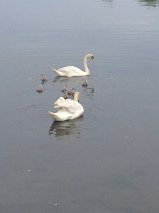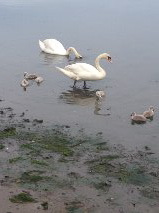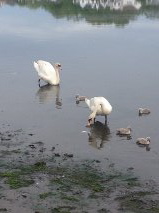They may be known as Invader swans, but six little fuzzball cygnets along with their elegant parents made our weekend. The mature mute swans seemed to recognize us from last year and that we’re good for a morning and evening meal as they quickly approached us from the other side of the bay proud to show off their new family. Some critics have described them as aggressive particularly around their young; however, the male eats out of our outstretched hands. The cygnets have a gray downy coat, but the all-white adults with their S-shaped necks and orange beaks and black knob at the base identify them as Mute Swans.
Mute Swans were introduced to United States breeders, parks, and zoos from Western Europe in the late 1800‘s,but are natives of northern and central Eurasia. Many have escaped captivity or were released to ponds, rivers, and coastal lagoons. They eat submerged aquatic vegetation (SAV) which also serves as waterfowl food, and as a filter for pollution runoff. The more SAV, the higher the water quality. The babies rely on insects dug up from the marsh shoreline by their parents.
Typically, the average brood is 3-8 cygnets. Last year we saw three from the same adults, so we’re very thankful this year for the bonus. In about 20 months these cygnets will start forming bonds of their own and begin their own families in four to five years. Typically silent, we do hear an occasional hissing noise and snapping-bill sound just to let us know they’re around and to catch our attention for a second-helping.
For additional wildlife stories see our category archives “Animal Welfare Ambassadors” and “Respect for Mom, Even If She Lays Eggs.”
Susan Sacirbey
PHOTOS: Personal Collection






